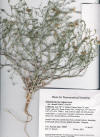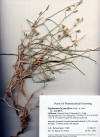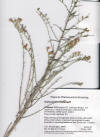|
Stephanomeria
exigua |
Stephanomeria
pauciflora
|
Stephanomeria
pauciflora |
Stephanomeria
pauciflora |
|
Stephanomeria
virgata
|
CA: Kern Co., Pacific Crest
Trail, north of
|
|
Trees and Shrubs of Kern County (Sep 2012) Key to woody species of Stephanomeria
1. Plants intricately branched, much like tumble weed; leaves mostly
1. Stems relatively few, laxly branched; leaves mostly present at
flowering, 2. Leaves with tentacle to tooth-like lobes along margins...... Stephanomeria parryi 2. Leaves with remote triangular teeth or entire............ Stephanomeria cichoriacea Stephanomeria cichoriacea A. Gray 1865. Chicory leaf. Flowering stems mostly single and erect well above a branched woody leafy base, the individual plants often aggregate into a large mat; leaves on lower half of flowering stems narrow elliptic, 5–10× longer than wide,10–20 cm long; entire or with scattered triangular teeth along margins; flowers May–Nov, pink lavender, all ligulate. Of scattered occurrences in chaparral, mixed evergreen forest, and coastal scrub from near sea level to 2,134 m; South Coast Ranges to Peninsular Ranges, and Channel Islands, CA. Type from near Fort Tejon, Kern Co. Kern Co.: Rare from the Mt. Pinos region east to Ft. Tejon (Bitter Creek on the south side of the Mt. Pinos at 7,000 feet elevation; among rocks in the canyon 0.5 mile west of Ft. Tejon (Twisselmann). Stephanomeria parryi A. Gray 1863. Parry’s wire lettuce. Flowering stems ascending from an underground thick stem, mostly short, simple to sparingly branched, zigzagging; leaves more abundant towards base, 5–10× longer than wide, mostly uniform in width, 2–6 cm long, reduced in length upwards along stem, entire or with scattered downward directed triangular teeth along margins; flowers May–Jun, pink lavender, all ligulate. Of scattered occurrences on desert slopes, 700–2,100 m; Eastern Sierra Nevada and White Mts. south to San Bernardino Mts., mountain ranges in eastern Mojave Desert to Southern Nevada and Utah, and to the Grand Canyon region of Arizona. Type from near St. George, UT. Kern Co.: Eastern Sierra Nevada, Indian Wells Valley, Short Canyon; West Mojave Desert, 9 miles south of Mojave on Hwy 14, Dry Lake on Edwards Air Force Base, 5 miles north of Ricardo, Leuhman Ridge, Red Rock Canyon; 1 mi east of jct. of Oak Creek and Willow Creek Roads (all collected during May), 785–1,188 m (CCH). Stephanomeria pauciflora (Prenanthes pauciflora Torrey 1827) A. Nelson 1909. Wire lettuce. Round bush, knee high, with numerous milky-latex stems, shortly branched, the branches tightly packed together like a tumble weed, the stems green, appearing leafless, arising from a short woody base usually obscured by bushy growth; leaves widely separated on lower stems, thread-like to 5 cm, flexuous; flowers May–Oct, pale lavender, all ligulate. Widely distributed in low elevation desert communities, below 5,000 ft, often in washes, ditches, and along roadsides, creosote scrub to Joshua tree woodland, grassland plains, California to Kansas and Texas, Chihuahua and Sonora Mexico. Type from Rocky Mts. Kern Co.: Common on the desert and in arid places through the Douglas oak and pinyon woodlands in the mountains; occasional in the valley and in light arid soils in the Temblor Range” (Twisselmann), 243–2,119 m (CCH). Root used by Hopi and Navajo to increase mother’s milk and to hasten delivery of placenta, and as a narcotic (Moerman). Sample of the whole plant with root collected in 1962 was active in KB Cell Culture; recollection of the plant without the root in 1967 failed to confirm. Root samples submitted to the NCI by the WBA during 2001–04 for antitumor screening, extraction completed in 2008. Test results unknown.
|
|






